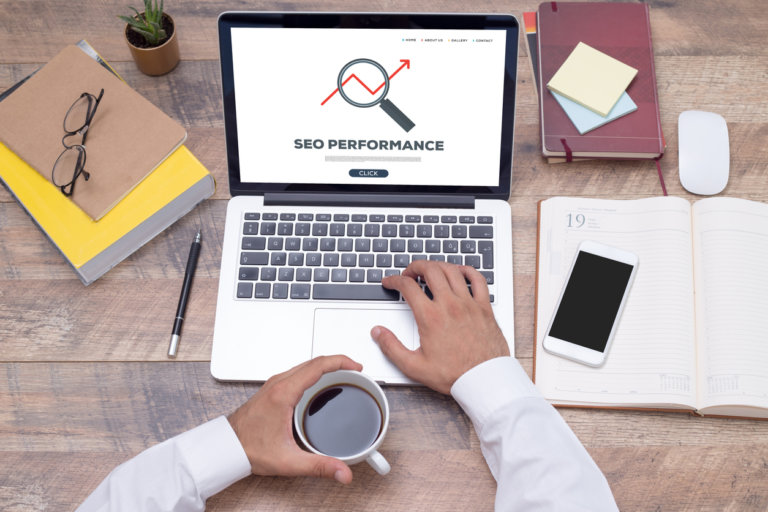Your conversion rate drops by about 4.42% for every second a visitor must wait for your website to load. This means that you could have killer keywords and tons of backlinks, but poor web performance could thwart even the best SEO strategy!
Many agencies limit their SEO offerings to common tactics like on-site optimization, link-earning, and content strategy. However, website performance is an equally important but less discussed component of SEO. To reach your SEO goals, it’s essential that web development and site maintenance not be siloed from search engine optimization. If you are starting to work on your site’s optimization, you may find it beneficial to redesign your website completely from scratch with SEO in mind (most SEO agencies can assist with this). Otherwise, problematic code could obstruct your entire SEO strategy.
This article explains how web performance affects SEO, four key tips to improve your site’s performance, and an important caveat about the limits of an agency’s ability to help improve your SEO with a pre-built website.
How does site performance affect SEO?
Google uses a lot of factors to rank your website. Every SEO factor is either related to a human user’s experience of your site or the search bots’ experience of your site—and website performance is a key determinant for both humans and algorithms.
For example, a website that is optimized for fast loading times will result in a great user experience. Click-through rate, time spent on site, and bounce rate are all signaling factors to Google’s algorithm—and site performance matters for each one of these elements, too.
The four key elements to help you achieve stellar web performance
Web performance is affected by a lot of things, but you can achieve good results by focusing your efforts on four key elements: page loading time, crawlability, security, and navigation.
Page loading time
According to a Google study, more than half of mobile visitors will click away if the website takes longer than three seconds to load. Half of mobile visitors expect a page to load in less than two seconds.
Google emphasized the importance of page loading times with the release of Core Web Vitals. The code behind the site can seriously affect page loading times. The solution is to work with a seasoned web developer who prioritizes UX.
Crawlability
In simple terms, crawling is when Google’s search bots explore (or crawl) your website to rank how easy it is to get around. Crawlability is how well your site makes sense to Google.
To help the bots navigate successfully (and thus rank you highly) your website must provide clear signage, accurate maps, and labels for everything.
There must be no dead-ends or orphan pages. Every page should have internal links that connect it to another page.
If you have a page that delivers value through visuals, make sure that all photos have appropriate descriptions and videos have transcripts. While search engines are very smart, they still cannot make sense of videos or images without textual context.
Security
As part of its ranking criteria, Google wants to know whether a site has a secure, encrypted connection. This is nothing new—Google has always preferred safe websites with proper encryption. However, we still encounter so many law firm websites that don’t have HTTPS encryption. This is a major no-no, as many users will receive an automatic security warning before entering a website without HTTPS encryption.
Good security protocols help your website rank higher on the search engine results page.
Navigation
When designing a navigation structure for your website, you must consider bots and humans. Search engines need structure to understand how all your content is related. Human visitors need a clear hierarchy to help them quickly and confidently find answers to their questions.
Google’s John Mueller explained recently that the preferred architecture is a pyramid site structure. While the “correct” navigation structure has been the subject of much debate, simple language and clear categories will serve both humans and bots.
A word of warning: SEO is best achieved from the ground up
You may be reading this article because you need SEO help for your existing website. Unfortunately, we typically cannot help in this situation.
Site architecture and functionality are so critical to SEO strategy that a pre-built website severely limits our ability to assist you.
Furthermore, if your website has a proprietary system, this can create additional barriers to making the structural changes necessary for optimal performance. A better alternative is WordPress, a platform that allows you to futureproof your website and pivot as search engines release new updates.
Overall, the key to SEO is a ground-up approach. Build a functional website that is optimized for user experience and crawlability. Then, layer on things like content strategy and link-building.
Review and next steps
Web performance is a critical component of SEO. There are a few key website structural components and performance measurements that matter most to the search engines:
- Page loading times
- Crawlability
- Security
- Navigation
The most effective SEO strategy is built from the ground up. In other words, SEO must be baked into the architecture of your website rather than sprinkled on top as an afterthought. Get expert SEO assistance from the Omnizant team and request a quote.

